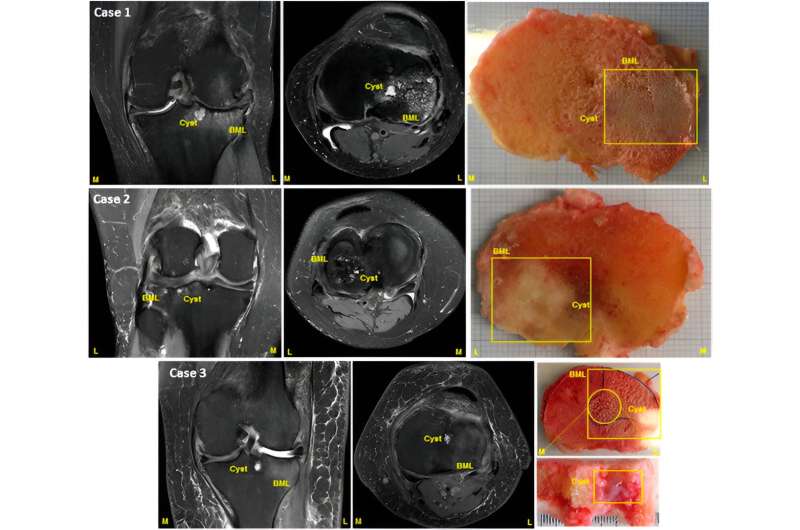This article has been reviewed according to Science X's editorial process and policies. Editors have highlighted the following attributes while ensuring the content's credibility:
fact-checked
trusted source
proofread
New bone tool could offer speedy screening for new treatments targeting pain in osteoarthritis

Researchers at St George's, University of London have developed a simple tool to measure irregularities in the cartilage and bone tissue of people with osteoarthritis, which aims to speed-up screening for tissue changes and testing new treatments for those with chronic pain.
Osteoarthritis affects about 10 million people in the U.K., with many of those experiencing knee pain. For years it has been well established that pain is linked to damage in the cartilage that cushions the knee joint, but Professor Nidhi Sofat's team discovered that pain is also associated with tiny fluid-filled "rips" in the bone called bone marrow lesions (BMLs).
MRI scans are key to identify these abnormal lesions in the knee joint and irregularities in the surrounding tissue, and consequently determine the cause of pain. However, due to the vast number of people living with knee osteoarthritis, access to a scan is very limited. This means many people do not get a diagnosis of their pain until later in life and are referred to a musculoskeletal physiotherapist or offered lifestyle advice to ease symptoms.
To address this major gap in our understanding of the causes of pain in osteoarthritis, Professor Sofat led a program of work in collaboration with colleagues at the University Nottingham to develop the Osteoarthritis Bone Score (OABS). The findings are published in the journal Osteoarthritis and Cartilage.
Seven key features
The scoring system is based on the presence or absence of seven key features in the BMLs—inflammation, scarring, thickened bone, increased blood vessels, cysts, changes in bone integrity and newly formed but unwanted cartilage—to produce a score between 0 and 7.
The tool was developed by firstly using an MRI scanner to find areas of BMLs inside the tibia bone just below the knee in 10 people with osteoarthritis at the time of their total knee replacement surgery. The team found that the regions with most BMLs were located next to the areas of most cartilage damage, which was visible to the surgeon's naked eye. They looked at the microscopic differences between the areas that contained BMLs and those that were absent of BMLs
Laboratory analysis, using chemical stains and microscope-based investigations were used to look at what was found within a BML, which determined the seven key characteristics for the OABS.
Researchers then validated the scoring system on 140 knee tissue samples from total knee replacements and 23 "normal" knee samples from a biobank. The seven anatomical features were compared in the samples with and without osteoarthritis, and the OABS score accurately identified these within the BMLs in osteoarthritis.
Opening up research possibilities
The researchers say that this tool will open up the possibility of larger studies into BMLs and pain without the need for MRI scanning, and allow for a more detailed investigation into the cells and molecules that underpin the changes in osteoarthritis.
"The creation of this tool is a major step forward in pain management research. We hope to develop it into a biomarker to better our understanding of the role of BMLs, and why they cause pain. It negates the need of an MRI scan, so our ultimate aim is that it can be used by doctors in clinical studies to fast-track the development of new treatments targeted at pain management of their patients," says Professor Nidhi Sofat, professor of rheumatology at St George's, University of London.
The team are now looking at taking the OABS and exploring its use in other forms of osteoarthritis including the hand.
More information: S. Koushesh et al, The osteoarthritis bone score (OABS): a new histological scoring system for the characterisation of bone marrow lesions in osteoarthritis, Osteoarthritis and Cartilage (2022). DOI: 10.1016/j.joca.2022.01.008



















